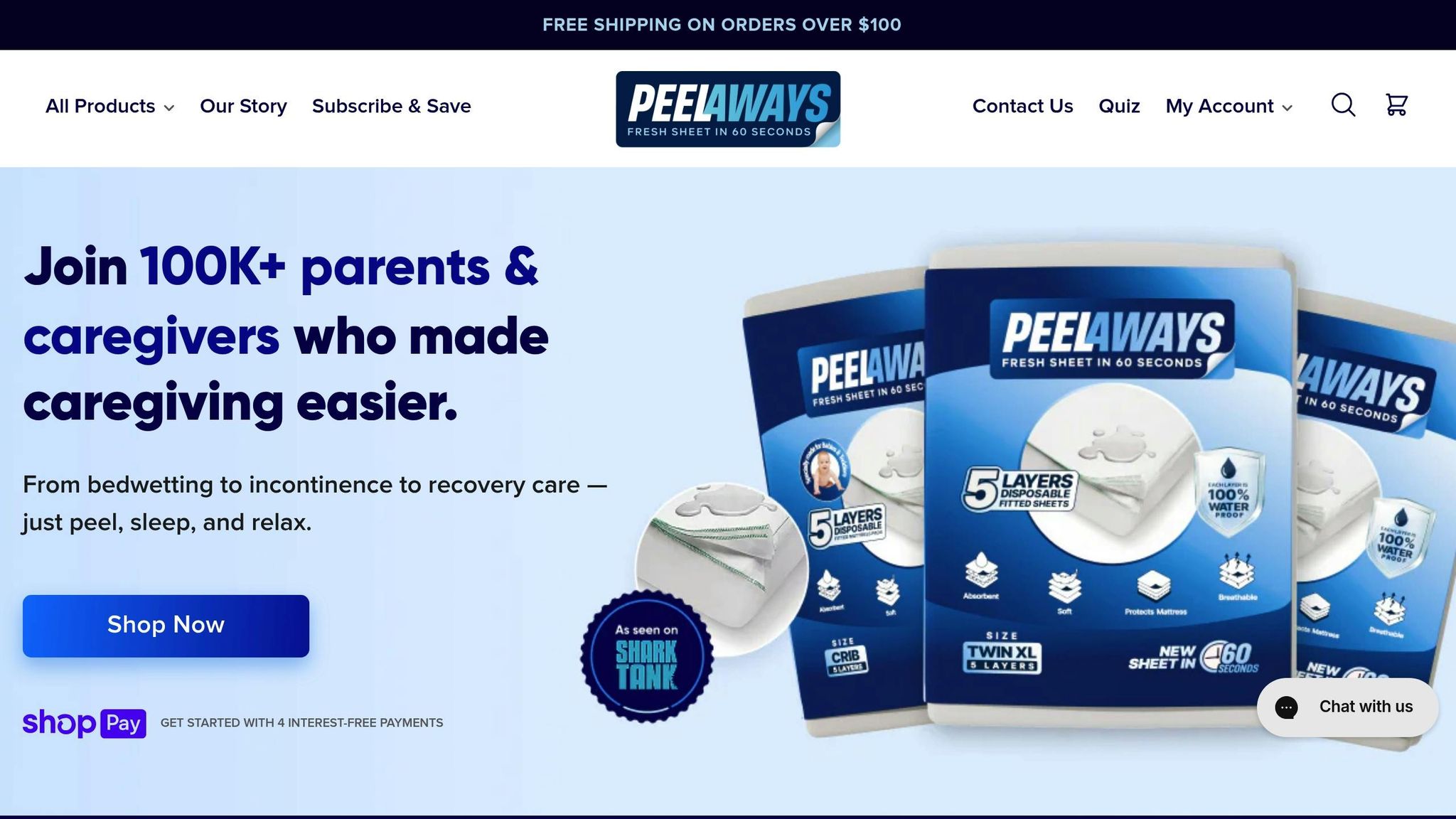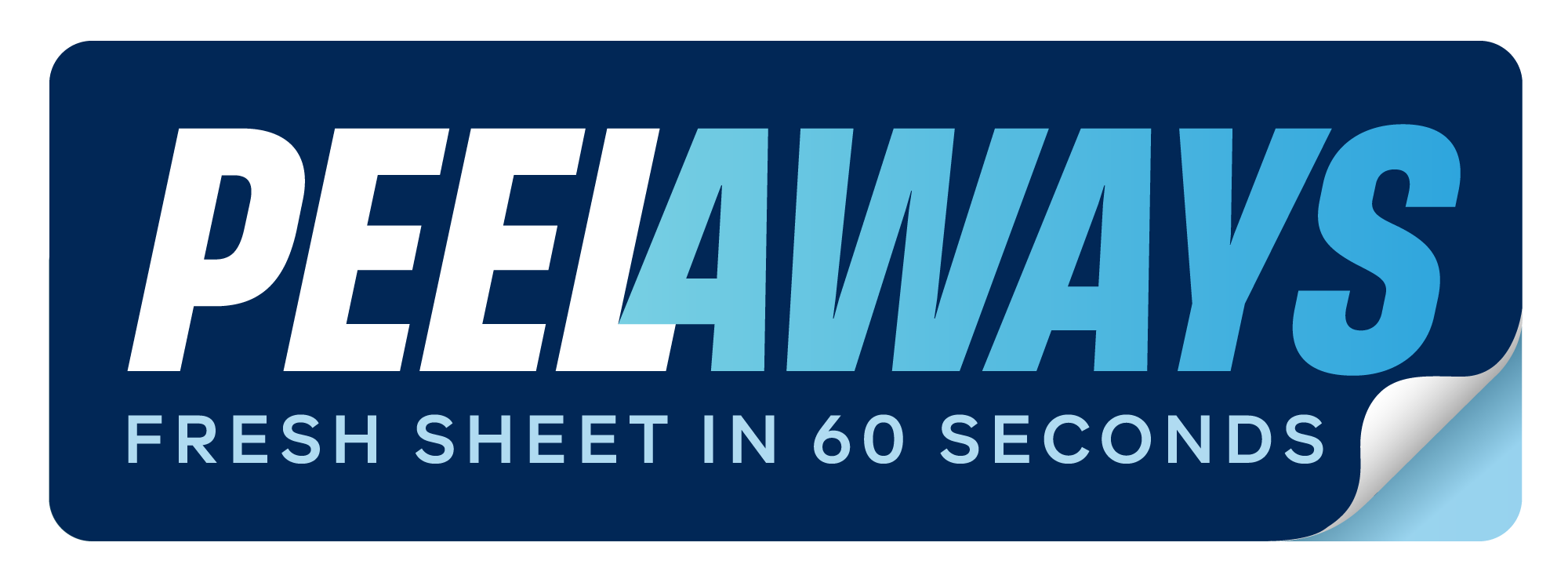Innovations in Bedding for Cross-Contamination Control

In healthcare, bedding is essential for preventing infection and controlling cross-contamination. Two modern solutions - PeelAways disposable sheets and reusable antimicrobial bedding - offer distinct ways to address these challenges:
- PeelAways Disposable Sheets: Multi-layer sheets that allow quick removal of soiled layers without laundering. They reduce contamination risks and save time but contribute to waste.
- Reusable Antimicrobial Bedding: Long-lasting bedding treated to resist bacteria and fungi. These are eco-friendlier but require strict laundering protocols to maintain hygiene.
Key Takeaway: PeelAways are ideal for high-risk environments needing quick, hygienic solutions, while reusable options suit lower-risk settings prioritizing reduced waste and long-term cost savings.
Typical One Step Cleaning and Disinfection Process for Hospital Beds and Mattresses.
1. PeelAways Multi-Layer Disposable Sheets

PeelAways provides a clever answer to the challenges of maintaining hygiene in healthcare and caregiving settings. Their 5–7 layer waterproof sheets are designed for quick removal, offering a practical way to improve cleanliness and efficiency.
Contamination Prevention
These sheets combine waterproof layers with a breathable membrane, effectively blocking bodily fluids, medications, and other contaminants from penetrating through while allowing airflow to keep the surface dry. When a layer becomes soiled, caregivers simply peel it away and dispose of it - no need for handling, washing, or transporting heavily soiled linens.
"They do not seep through to next liner and so much easier to use than changing sheets everyday for elderly", – linda [1]
This ease of use is echoed by another customer:
"After clean up and I peeled away the top layer, nothing. I mean nothing soaked, seeped through, not even smell" – Stephanie Jackson [1]
This protective design not only prevents contamination but also makes cleanup far simpler and more hygienic.
Ease of Use and Efficiency
PeelAways doesn’t just protect - it saves time. Traditional bed changes, which often involve lifting mattresses and stripping beds, can be cumbersome and time-consuming. With PeelAways, caregivers can restore a clean sleeping surface in seconds by removing a single layer. This streamlined process frees up time for more critical patient care tasks.
Cost-Effectiveness
PeelAways sheets range in price from $30.99 for the Crib-A-Peel size to $53.99 for King-size sheets [1]. While the upfront cost may seem higher, the multi-layer design eliminates the need for frequent laundering, cutting down on water, detergent, energy, and labor expenses. Additionally, the reduced risk of infections translates to lower infection control costs.
One user highlighted the convenience:
"They said it is more convenient to use than sheets, less washing, just peel off soiled layer and throw out" – Kalahiki Jr Samuel [1]
With sizes ranging from toddler-friendly Crib-A-Peel to King-size sheets for adults, PeelAways offers a versatile solution that works across different patient needs - all without requiring separate purchases for varying populations.
2. Reusable Antimicrobial Bedding
While PeelAways focus on convenience with disposable layers, reusable antimicrobial bedding offers a long-lasting and eco-conscious alternative. Unlike single-use options, these products are built for durability and are ideal for facilities with centralized laundry systems and a commitment to sustainability. Their secret lies in antimicrobial treatments embedded directly into the fabric.
Contamination Prevention
Reusable antimicrobial bedding is designed to help prevent the spread of bacteria and other microbes. This is achieved through agents like silver ions, copper, or specialized chemical finishes bonded to the fabric. For instance, Medline Sofnit 300 underpads pair a soft topsheet with a waterproof backing that resists fluids and stains. Strict quality control ensures these antimicrobial properties remain effective over time.
Ease of Use and Efficiency
These bedding products simplify caregiving by reducing the need for frequent full bedding changes. For patients who are bedridden or dealing with incontinence, the absorbent core locks in fluids, eliminating the need for constant mattress cleaning or heavy sanitization efforts. This thoughtful design not only saves time but also improves patient comfort.
Cost-Effectiveness
Although the initial cost of reusable antimicrobial bedding can be higher, it pays off in the long run. A single reusable pad can replace dozens of disposable ones over its lifespan, significantly lowering expenses for facilities with high patient turnover and robust laundry systems. Beyond the financial benefits, these products also contribute to reducing waste.
Impact on Environment
Reusable antimicrobial bedding stands out for its environmental advantages. By cutting down on disposable waste, these products help reduce the amount of material sent to landfills. Additionally, they lower the environmental impact tied to manufacturing, packaging, and disposal. When paired with efficient washing and sterilization practices, they offer a practical solution for organizations aiming to balance infection control with ecological responsibility [4].
sbb-itb-45288fe
Pros and Cons
When it comes to bedding technologies aimed at controlling cross-contamination, each option has its own strengths and drawbacks. Knowing these trade-offs allows healthcare facilities, caregivers, and families to make informed decisions tailored to their specific needs.
PeelAways multi-layer disposable sheets are known for their convenience and effectiveness in infection control. Their patented peel-away design minimizes cross-contamination risks by allowing soiled layers to be quickly removed and discarded. This saves caregivers significant time, as bed changes can be completed in under a minute without needing to lift mattresses or handle contaminated linens. This feature is particularly beneficial for sensitive or high-risk populations.
That said, disposable sheets come with environmental concerns. While PeelAways cut down on water use and eliminate the need for laundry, their 100% disposable nature means they contribute to landfill waste. Costs can vary: facilities with high patient turnover might find the time-saving benefits outweigh the expense, but long-term care settings could face higher cumulative costs over time.
Reusable antimicrobial bedding, on the other hand, offers benefits like reduced waste and potential cost savings in the long run. These sheets are designed with antimicrobial treatments that help prevent the growth of bacteria and fungi, offering ongoing protection when properly maintained. While the upfront cost is higher, their durability can offset this over time.
However, reusable options come with their own challenges. They require strict laundering protocols to maintain hygiene standards, and improper washing can increase cross-contamination risks. Additionally, frequent laundering can gradually wear down the antimicrobial properties, impacting their effectiveness. Facilities must also consider the costs and logistics of managing laundry services and maintaining adequate inventory, especially in high-turnover environments.
Here’s a side-by-side comparison of these two approaches:
| Feature | PeelAways Multi-Layer Sheets | Reusable Antimicrobial Bedding |
|---|---|---|
| Cross-Contamination Control | Excellent - no risk with peel-away layers | Good - depends on proper laundering protocols |
| Convenience | High - under 1-minute changes, no laundry | Moderate - requires washing and inventory management |
| Environmental Impact | Higher waste, reduced water usage | Lower waste, increased laundering resources |
| Cost Structure | $30.99-$53.99 per unit, higher long-term costs | Higher upfront, lower long-term expenses |
| Maintenance | None required | Strict laundering protocols essential |
| Effectiveness Over Time | Consistent performance | May degrade with repeated washing |
| Best Use Cases | Healthcare, elder care, high-risk environments | Long-term care, lower-risk settings, sustainability-focused facilities |
Experts in infection control often recommend disposable bedding for high-risk environments, as it provides superior protection against cross-contamination. Reusable antimicrobial bedding, however, can be a great fit for lower-risk settings where proper maintenance aligns with sustainability goals. Some facilities even adopt a hybrid approach, using disposables in high-risk situations and reusables elsewhere to strike a balance between infection control and environmental impact [2].
Ultimately, the decision comes down to weighing immediate benefits like convenience and infection control against longer-term considerations like environmental impact and cost. Each facility must evaluate its specific needs, staffing resources, and priorities to choose the best solution for its unique circumstances.
Conclusion
PeelAways are ideal for high-risk environments, while reusable antimicrobial bedding fits better in settings focused on sustainability and lower risk. Each option serves a specific purpose in reducing cross-contamination.
PeelAways shine in high-risk scenarios where infection control is a top priority. Places like hospitals, elder care facilities, and homes caring for immunocompromised individuals can benefit greatly from the single-use layers that eliminate cross-contamination risks. The convenience of quickly replacing sheets without handling contaminated linens saves staff time and helps lower infection rates [3].
On the other hand, reusable antimicrobial bedding works well in lower-risk environments that prioritize sustainability and have the resources to maintain strict laundering protocols. Home care settings with reliable washing facilities might find the long-term cost savings and reduced environmental footprint appealing.
For most U.S. healthcare providers and caregivers aiming to minimize cross-contamination, disposable options like PeelAways offer a practical solution. When you consider the costs tied to healthcare-associated infections, staff time, and laundry management, these multi-layer disposable sheets provide both immediate protection and lasting value.
These advancements highlight the progress in bedding technology, setting new benchmarks for infection control in healthcare environments.
FAQs
How do Peelaways disposable sheets compare in terms of cost and environmental impact to traditional reusable bedding?
Peelaways disposable sheets provide an affordable and practical alternative to traditional bedding by cutting out the need for constant washing. Their clever multi-layer design lets you peel off a used layer to instantly reveal a fresh, clean sheet beneath. This eliminates the time, effort, and costs tied to laundering reusable sheets.
Unlike regular bedding that demands ongoing upkeep with detergent, electricity, and water, Peelaways are 100% disposable. They also help reduce the risk of cross-contamination, offering a hygienic option without the environmental impact of frequent washing. These features make them especially useful for caregivers, medical facilities, and families who value both convenience and cleanliness.
How can I maintain the hygiene and effectiveness of reusable antimicrobial bedding over time?
To keep reusable antimicrobial bedding clean and effective, it's essential to follow the care instructions provided by the manufacturer. Use the recommended water temperature and a mild detergent that won’t interfere with the bedding’s antimicrobial features. Steer clear of fabric softeners and bleach, as these can diminish its performance.
Make it a habit to check your bedding for any signs of wear, like thinning fabric or damage, and replace it when necessary to maintain its functionality. When not in use, store the bedding in a clean, dry space to avoid contamination.
What healthcare settings benefit most from using Peelaways disposable sheets?
Peelaways disposable sheets are a game-changer in healthcare settings where reducing cross-contamination and simplifying cleanup are top priorities. They’re particularly useful in elder care facilities, special needs environments, and medical recovery spaces where bedding often needs to be changed multiple times a day.
Thanks to their multi-layer, peel-away design, these sheets eliminate the hassle of laundry, limit exposure to soiled bedding, and make daily care routines easier. For caregivers, nurses, and families, they offer a practical solution that keeps the environment clean while providing much-needed convenience and reassurance.
Related Blog Posts
- How Disposable Sheets Reduce Cross-Contamination
- FAQs About Anti-Slip Bedding for Patients
- How to Prevent Cross-Contamination in Bedding
- Checklist for Reducing Laundry in Hospitals
Comments
0

SAVE MONEY & WATER
Professionals & Institutions save a fortune on labor/laundry.

SUPERIOR COMFORT
The first thing our customers notice is how soft our sheets are.

100% WATERPROOF
Each layer is 100% Waterproof, perfect for spills and accidents

SAVE TIME
Change the sheet in under 1 minute without stripping the bed.




Leave a comment